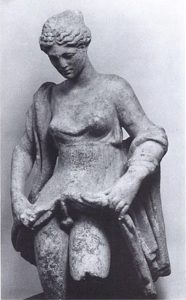Lesson Objectives:
- disaggregate (separate) and define sex, gender and orientation
- explain how sex and gender and socially constructed cross-culturally
- evaluate how sex and gender constructs affect individual, group and societal experiences
- formulate a solution to a sex and gender construct conflict
 Contemporary social scientists approach sex, gender and orientation as three separate, yet interconnected, components (Butler 1990). This perspective emerged from social research in the 20th century which began to challenge prevailing assumptions that correlated biological and binary sex categories with specific gender identities and sexual orientations. American psychoanalyst Robert Stoller was among the first to change the way the social sciences approached sex, gender and sexuality in his book, Sex and Gender (1968). In his investigation, Stoller relied on ethnographic interviews to develop a new approach that separated biological sex from gender identity formation and sexual arousal. According to Stoller, gender identity is not only influenced by biological and hormonal influences, it is also informed by sex assignment at birth as well as environmental and psychological influences. Although contemporary approaches to gender research have developed more nuanced approaches to biological sex and gender identity (see Butler below), Stoller’s research opened the door for new social and philosophical perspectives on sex, gender and orientation.
Contemporary social scientists approach sex, gender and orientation as three separate, yet interconnected, components (Butler 1990). This perspective emerged from social research in the 20th century which began to challenge prevailing assumptions that correlated biological and binary sex categories with specific gender identities and sexual orientations. American psychoanalyst Robert Stoller was among the first to change the way the social sciences approached sex, gender and sexuality in his book, Sex and Gender (1968). In his investigation, Stoller relied on ethnographic interviews to develop a new approach that separated biological sex from gender identity formation and sexual arousal. According to Stoller, gender identity is not only influenced by biological and hormonal influences, it is also informed by sex assignment at birth as well as environmental and psychological influences. Although contemporary approaches to gender research have developed more nuanced approaches to biological sex and gender identity (see Butler below), Stoller’s research opened the door for new social and philosophical perspectives on sex, gender and orientation.
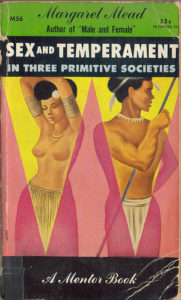 Theoretical arguments such as Stoller’s were largely informed by early anthropological research on sex and gender which had already offered evidence that challenged prevailing ideologies that sex and gender were universal categories shared cross-culturally. Margaret Mead was among the first anthropologists to identify variation in gender roles and gender ideologies. In her books, Sex and Temperament in Three Primitive Societies (1935) and Male and Female (1949), Mead relied on ethnographic information from three social groups in New Guinea to show cross-cultural variation in male and female roles as well as differences in ideas about femininity and masculinity. Small-scale variation among three closely related social groups located on a single small island called for a greater look at cross-cultural variation world-wide. As a result, contemporary anthropological approaches to sex, gender and orientation necessitate the disaggregation of the three components.
Theoretical arguments such as Stoller’s were largely informed by early anthropological research on sex and gender which had already offered evidence that challenged prevailing ideologies that sex and gender were universal categories shared cross-culturally. Margaret Mead was among the first anthropologists to identify variation in gender roles and gender ideologies. In her books, Sex and Temperament in Three Primitive Societies (1935) and Male and Female (1949), Mead relied on ethnographic information from three social groups in New Guinea to show cross-cultural variation in male and female roles as well as differences in ideas about femininity and masculinity. Small-scale variation among three closely related social groups located on a single small island called for a greater look at cross-cultural variation world-wide. As a result, contemporary anthropological approaches to sex, gender and orientation necessitate the disaggregation of the three components.
Sex
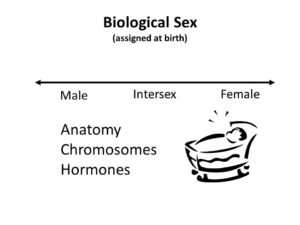 Sex is a biological category, or assignment, that can be based on the arrangement of chromosomes, hormones, and internal and external physical traits. Sex categories are socially constructed as some societies may create sex categories according to chromosomal arrangements, while others may categorize sex according to physical traits such as external and/or internal reproductive organs. Therefore, sex is a social construct because it is an invented idea that is created according to specific criteria that is established within a social system. This is why sex categories can vary cross-culturally. Once the categories are created with measurable indicators (DNA, hormone levels, anatomical traits, etc.), it is possible to categorize all humans based on the defining dimensions of the categories. It is important to note that in the natural world, sex is not a binary system solely based on two discreet (male or female) categories. Intersexuality, the state of possessing both ‘male’ and ‘female’ sex traits, exists in the plant and animal kingdoms as well as among human beings.
Sex is a biological category, or assignment, that can be based on the arrangement of chromosomes, hormones, and internal and external physical traits. Sex categories are socially constructed as some societies may create sex categories according to chromosomal arrangements, while others may categorize sex according to physical traits such as external and/or internal reproductive organs. Therefore, sex is a social construct because it is an invented idea that is created according to specific criteria that is established within a social system. This is why sex categories can vary cross-culturally. Once the categories are created with measurable indicators (DNA, hormone levels, anatomical traits, etc.), it is possible to categorize all humans based on the defining dimensions of the categories. It is important to note that in the natural world, sex is not a binary system solely based on two discreet (male or female) categories. Intersexuality, the state of possessing both ‘male’ and ‘female’ sex traits, exists in the plant and animal kingdoms as well as among human beings.
- Hermaphroditic marijuana plant
- Parrot fish change from male to female during their lifecycle.
- Belgian model, Hanne Gaby Odiele, uses her personal experience with intersexuality to help intersex children cope with difference
Some flora (such as the marijuana plant pictured above) can possess both male (stamens) and female (stigma) reproductive organs and are able to self-pollinate and produce offspring on their own. These plants are commonly referred to as hermaphrodites. In addition to hermaphroditic variations, many fauna (such as the parrot fish pictured above) change their sex throughout the course of their lifetime usually starting their lives male and later developing into female.
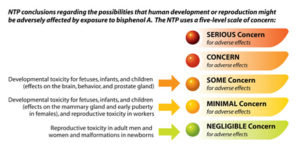 New Research is also finding that environmental contamination is increasing the rate of hermaphrodism in reptiles, fish and amphibians (see ‘Hermaphrodite Frogs Found in Suburban Ponds’ NYT). Similarly, a growing body of research is finding that increasing levels of pollution and contamination are impacting the sexual development of human male embryos, adolescence, and adult sperm productions. Endochrine disruptors, which are chemicals that affect the human endocrine system, such as bisphenalA (BPA) found in everyday plastics, inhibit hormonal functions that regulate human sexual development and processes and are resulting in a marked increase in babies born with sexually ambiguous genitalia. (To learn more about the impacts of contamination on human male reproductive development, watch the CBS documentary, The Disappearing Male.)
New Research is also finding that environmental contamination is increasing the rate of hermaphrodism in reptiles, fish and amphibians (see ‘Hermaphrodite Frogs Found in Suburban Ponds’ NYT). Similarly, a growing body of research is finding that increasing levels of pollution and contamination are impacting the sexual development of human male embryos, adolescence, and adult sperm productions. Endochrine disruptors, which are chemicals that affect the human endocrine system, such as bisphenalA (BPA) found in everyday plastics, inhibit hormonal functions that regulate human sexual development and processes and are resulting in a marked increase in babies born with sexually ambiguous genitalia. (To learn more about the impacts of contamination on human male reproductive development, watch the CBS documentary, The Disappearing Male.)
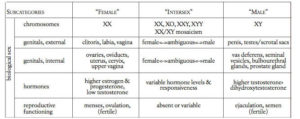 Although sex categorizations in euro-centric culture are usually based on binary male-female categories, intersexuality, or sexual ambiguity, is not uncommon among humans. In fact, intersexuality among humans is as common as twins or red hair. Humans may possess intersex chromosomal arrangements such as XXX, XXY, XO, and XYY, as well as a wide range of hormonal and physical traits that fail to fit neatly into either of the culturally designated male or female categories. This is why many societies have incorporated third sex categories into the cultural construct of biological sex. In the Dominican Republic for example, Guevadoces means ‘eggs at twelve’ which refers to individuals who were assigned to the ‘female’ category in childhood but developed external male traits (such as testicles, hence ‘eggs’) when hormonal changes occur during puberty. Western Scientists refer to this as ‘5-alpha reductase syndrome’. Visit the research website of Imperto et al to learn more about the third sex, Guevedoces
Although sex categorizations in euro-centric culture are usually based on binary male-female categories, intersexuality, or sexual ambiguity, is not uncommon among humans. In fact, intersexuality among humans is as common as twins or red hair. Humans may possess intersex chromosomal arrangements such as XXX, XXY, XO, and XYY, as well as a wide range of hormonal and physical traits that fail to fit neatly into either of the culturally designated male or female categories. This is why many societies have incorporated third sex categories into the cultural construct of biological sex. In the Dominican Republic for example, Guevadoces means ‘eggs at twelve’ which refers to individuals who were assigned to the ‘female’ category in childhood but developed external male traits (such as testicles, hence ‘eggs’) when hormonal changes occur during puberty. Western Scientists refer to this as ‘5-alpha reductase syndrome’. Visit the research website of Imperto et al to learn more about the third sex, Guevedoces
The Argentinian drama film below, XXY (2007), portrays the cultural dilemma facing the parents of a sexually ambiguous child born with XXY chromosomes. It dramatizes their struggle to accept their child for the way the child was born while facing social alienation of intersexuality within a cultural system that is strictly based on a binary, male-female, sex categorization for humans.
Increasing awareness of intersexuality and sexual ambiguity in scientific communities and popular culture seriously calls to question the construction of sex categories and social organizations that rest exclusively on a binary male-female paradigm. To learn more about the wide range of intersex variations in human biology, visit the website of the Intersex Society of North America and review the frequently asked questions (FAQ). For discussion, we will consider the implications of sexual ambiguity within a strict a binary sex-categorization system, and you will be expected to take a scholarly position on the conflicts associated wit binary sex categories in society (law, education, sports, identification cards, etc) and the realities of intersexuality.
Gender
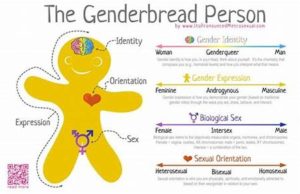 The ‘Genderbread Person’ was popularized in the 1990s as a visual means to represent the disaggregation of sex, gender and orientation (as well as identity and expression); and it has taken on many forms since its inception. The graphic not only displays the complexities associated with sex assignment, it also parses out variables associated with gender.
The ‘Genderbread Person’ was popularized in the 1990s as a visual means to represent the disaggregation of sex, gender and orientation (as well as identity and expression); and it has taken on many forms since its inception. The graphic not only displays the complexities associated with sex assignment, it also parses out variables associated with gender.
In this class, gender is defined as a cultural representation based on socially-constructed beliefs and practices regarding the roles, responsibilities and obligations that are, in some ways, tied to the biological and reproductive experiences associated with sex. Gender Roles are culturally defined norms, behaviors and obligations that are assigned and considered appropriate for a specific gender. Gender roles are sometimes tied to biology, such as the association of childcare with the woman gender due to biological ties to pregnancy and lactation among females. Gender can also be associated with ideas about masculinities and femininities which are clusters of traits that society assigns to specific genders or sexes, such as aggression, hairiness, and stature. Like sex, gender ideologies vary cross-culturally and they also change through time. For example, many Americans have ideas about the roles and responsibilities for men and women that are different than their parents ideas and radically different from their grandparent’s ideas. Similarly, many cultural groups in the US find it acceptable for women to wear slacks in public while some American religious groups consider it appropriate as well as some areas where women may face corporal punishment for crossing the same gender boundary (http://www.msnbc.msn.com/id/31897384/) Since gender is cultural, it is learned and shared, and this makes it dynamic as cultural ideas adapt to changing circumstances.
Different cultural groups not only differ on the social construction of the rights, duties and obligations associated with the gender roles of ‘men’ and ‘women’, but many societies also accommodate additional gender categories. In Southeast Asia, Hijra represents a third gender that at one time held an important role in religious and cultural rituals before British colonialism enforced a binary man-woman gender categorization that has marginalized Hijras in contemporary society.
In Albania, biological females who assume the gender roles of men are referred to as Sworn Virgins. Watch this National Geographic documentary to learn more. The third gender in Thailand is referred to as Kathoey. The film, Beautiful Boxer (2007), is based on the true story of Nong Tom, a whole struggled to balance his role as kathoey with his growing notoriety as an internationally recognized boxer.
Pre-colonial Navaho culture includes four genders; Asdzaan (woman), Hastiin (man), and two Nadleeh categories that include masculine females and feminine males. Today, Two-spirit refers to individuals in Native American cultures that perform multiple gender roles. Documented in more than 130 tribal groups, two-spirits were generally revered until European domination marginalized members outside of the binary gender paradigm. The documentary film, Two-Spirit (2010), tells the story of a two-spirit Navaho teen that was murdered in a modern hate-crime.
Archeological evidence is rich with evidence of multiple genders, transgender, and intersexualityfrom ancient art and mythology (Hermaphrodite nibru, ) to medieval texts such as the thirteenth-century lawyer, Henry of Segusio, who wrote that where no sex prevails an individual should choose their legal gender under oath. A wide range of third gender categories have existed and continue to persist throughout the world. Yet, European colonialism and the globalization of the binary man-woman gender paradigm has resulted in the persecution of third genders in post-colonial territories worldwide and continues to fuel political debates across Europe and the United States.
Gender Role Theories
Moving beyond counting genders, anthropologists now aim to understand how gender ideologies emerge in a society. In her book, Gender Trouble (1990), Judith Butler deconstructs gender by explaining how sex, gender and sexuality appear as natural correlates because social norms regulate conformity to specific essentialisms established by society. She contributed to the social understanding of gender as performative by theorizing that people are not born with gender, they act out gender according to social and cultural norms and expectations.
There are now a wide variety of approaches aiming to identify the origins of gender role formation. Evolutionary biologists present gender roles as cultural adaptations to the environment; different environments lead to gender diversity. Some psychologists point to cognitive mapping to unveil the psychological aspects of gender identity formation. From a social scientific perspective however, gender identity is considered a learned behavior that is acquired through socialization, the process of learning to behave according to societal norms, values and expectations.
For people living in cultures that have access to ultra-sound technologies that allow for pre-natal sex-determination, gender socialization can begin before a child is born as parents select gender-specific names, toys, clothing and room decorations. When sex is assigned at birth, childrearing practices and the differential treatment of boys and girls contribute to the child’s understanding and internalization of gender norms and behaviors. Children are often rewarded for stereotypical behavior and punished for non-conformity to gender expectations. Children also identify and imitate the gender roles performed by their parents. A growing body of research has also shown that toys and media play a significant role in gender socialization among American children. Compare the ways that the commercial advertisement below makes use of prevailing gender ideologies. What gender norms and values are conveyed to the child viewer?
Review the children’s book, ‘I’m glad I’m a Boy, I’m glad I am a girl!’ by Whitney Darrow. http://michiedo.blogspot.com/2008/12/im-glad-im-boy-im-glad-im-girl.html Consider the ways, if any, that gender roles and ideologies have changed since this book was published in the 1970s. What type of historical events generated new circumstances that contributed to those changes and changed the way you view gender roles today?
Orientation
Orientation or sexuality is based on the sex and genders that a person is attracted to emotionally, physically, sexually and romantically. Although social and cultural norms correlate sexuality with specific sex and gender categories, sexuality is approached by the social sciences as a distinctly separate aspect of the human experience.There is a massive body of research addressing orientation, particularly in the field of Queer Studies and Queer theory, that we will not get into in this course. It is important, however, to continue to disaggregate orientation and sexuality from gender and sex.
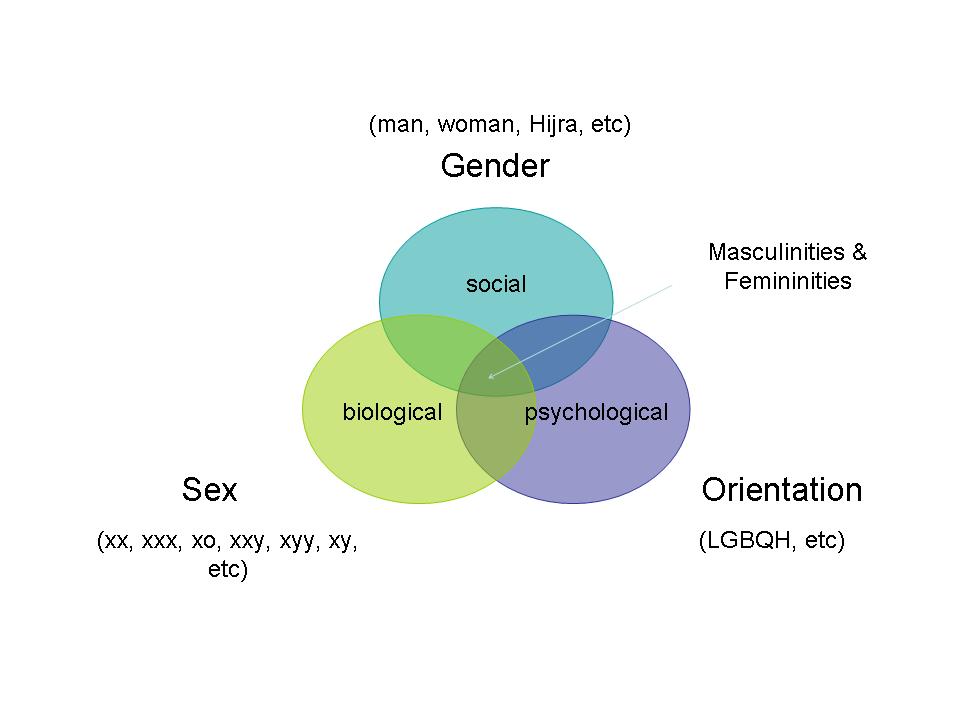 As you move through the course from this point, it is important to pay particular attention to your use of terms such as ‘sex’, ‘gender’ and orientation. It has recently become popular in U.S. society to use the term ‘gender’ to refer to biological sex.
As you move through the course from this point, it is important to pay particular attention to your use of terms such as ‘sex’, ‘gender’ and orientation. It has recently become popular in U.S. society to use the term ‘gender’ to refer to biological sex.  During a visit to the veterinarian’s office, the paperwork asked for my cat’s ‘gender’. Although my cat can be sex categorized as a biological male, having been born with two testicles and a penis, it is quite unlikely that he was enculturated to adopt socially-constructed beliefs and practices regarding his roles, responsibilities and obligations that are tied to his experience as a biological male. His feline mother did not socialize him to meow or behave differently than his female litter mates. As his human caretaker however, I engendered him by naming him ‘Oliver’ instead of ‘Olivia’, by providing him with a blue-colored collar rather than a pink one, and by occasionally making fun of his high-pitched feminine meow. Names, colors and mannerisms are the ways that humans make symbolic associations that lend meanings and serve to organize and interpret reality. These associations helped to situate a biological male cat within the social schema of a human household. In the next section, we will explore the ways that symbolic meanings and associations help to socially organize people within the context of marriage, family and household.
During a visit to the veterinarian’s office, the paperwork asked for my cat’s ‘gender’. Although my cat can be sex categorized as a biological male, having been born with two testicles and a penis, it is quite unlikely that he was enculturated to adopt socially-constructed beliefs and practices regarding his roles, responsibilities and obligations that are tied to his experience as a biological male. His feline mother did not socialize him to meow or behave differently than his female litter mates. As his human caretaker however, I engendered him by naming him ‘Oliver’ instead of ‘Olivia’, by providing him with a blue-colored collar rather than a pink one, and by occasionally making fun of his high-pitched feminine meow. Names, colors and mannerisms are the ways that humans make symbolic associations that lend meanings and serve to organize and interpret reality. These associations helped to situate a biological male cat within the social schema of a human household. In the next section, we will explore the ways that symbolic meanings and associations help to socially organize people within the context of marriage, family and household.
Readings: Lang and Kuhnle. 2008. ‘ Intersexualityand Alternative Gender Categories in Non-Western Cultures’ in Hormone Research Vol 69 (240-250)
Your Score:
Your Ranking:
Discussion: Watch the documentary ‘Me, My Sex and I’ , and consider the personal experiences with intersexuality for each case study presented in the film. Use the information presented in the documentary, on this webpage, the Lang and Kuhnle article, and the ISNA website to formulate a solution to the following hypothetical situation; If you were parent or guardian of a child who was born with sexual ambiguity, how would you raise that child in your household, community, and society? Would you chose a sex and gender for the child and raise them ‘as if’ or would you raise the child gender neutral until they were old enough to decide? How would you negotiate the binary sex organization that is pervasive within public school system, sports and recreational teams, and other activities popular with children? What type of actions would you take to raise awareness with those who will interact with the child (teachers, students, coaches, etc.) to prevent the child from being alienated, excluded or made fun of? How would you explain sex and gender to the child in a way that would account for the disconnect between what they are experiencing in their life (draw from the case studies in the film) and the binary categories in our language, toys, cartoons, etc?
Tucker Carlson Extra Credit: Watch the video below. Create a video response explaining the difference between sex and gender to Tucker Carlson and the student in the video. Remember, there are no ‘right’ or ‘wrong’ perspectives. You will be evaluated on your ability to use terms and concepts and by reading and responding to other student posts.
When you complete the discussion, move on to the Marriage, Households & Family lesson.




